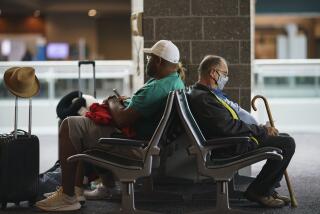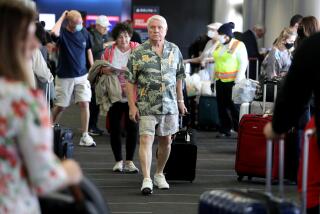Flying With a First-Class Cold
- Share via
No sooner do you book a flight than it happens. First a sniffle, then another, followed by full-fledged sneezing. You know you’re going to be uncomfortable but what you may not know is that flying with a cold can set you up for ear problems, in addition to pain. It can make existing ear infections more painful. Although it’s not always possible to cancel flight plans, there are ways to help make the journey tolerable and safe.
Begin by taking oral decongestants several days before a flight, suggested Dr. Christopher W. Traughber, a travel medicine specialist and medical director of the Immediate Medical Care Centers in Palos Verdes Peninsula and San Pedro. Decongestants are recommended because they reduce fluid buildup, thus reducing pain, according to Dr. Richard Bock, senior medical director at FHP in Van Nuys, a health maintenance organization.
Combining the decongestant with an over-the-counter antihistamine can help even more, Bock said. “Over-the-counter medicines are usually good enough,” he said. But travelers with allergy problems or very bad colds may want to ask their doctor for stronger, prescription medicine.
A half hour or so before descent, Traughber suggests using a nasal spray to further decongest. To minimize ear pain, chew gum, yawn or sip water, he added.
Taking a hard swallow frequently can help, too, added Dr. Jimmy Hara, director of family practice residency at Kaiser Los Angeles Medical Center and UCLA associate clinical professor of family medicine. But be warned: Taking motion sickness medicine, such as Dramamine, in combination with an antihistamine of any kind can cause significant drowsiness, he said.
If you suspect a cold is accompanied by an ear infection, it’s a good idea to check with your doctor before boarding a flight, doctors agree. By itself, a cold is often accompanied by congestion of the Eustachian tubes--the structures between the middle ear and upper part of the throat that equalize pressure on both sides of the eardrum. When aggravated by pressure changes connected with flying, significant ear pain can result. Flying with an ear infection can also lead to a ruptured eardrum, caused by unequal air pressure changes on either side of the eardrum.
Children who come down with colds before air travel should be seen by their doctor before takeoff, said Thousand Oaks pediatrician. Dr. Kenneth Saul. Since ear infections are more common in children than adults, he said, “I like to have the kids checked because sometimes they can have an ear infection without a lot of symptoms.”
Even if ears are not affected, Saul tells parents there is a higher likelihood of a cold affecting children’s ears during air travel. To protect against this, parents should have children suck on candy during descent. “Take a decongestant during the flight, too,” he added. If a child also has allergies, consider using a combination of over-the-counter decongestant and antihistamine, Saul added, although it is always best to check with the child’s pediatrician before administering any type of medication.
Children who have ventilating tubes in their eardrums (to help prevent middle ear infections) are at reduced risk for ear problems aloft, Saul said, because the tubes help to equalize the pressure.
If you forget antihistamines and decongestants, don’t expect any supplies on board. “Flight attendants are not allowed to dispense any kind of medicine except what is boarded--currently just acetaminophen (Tylenol),” according to a United Airlines spokesman.
In years past, flight attendants would often suggest that passengers with clogged ears hold a foam cup filled with a steaming washcloth nearby, but this is a practice doctors have recently advised against, according to a Southwest Airlines spokeswoman. Not only can the hot water burn, she said, the moisture is not considered good for the ears.
To minimize ear pain when landing, the Valsalva maneuver can help, but it’s not advised for those with a history of ear surgery or problems. It’s done by gently pinching the nostrils together, keeping the mouth firmly shut and then blowing.
Once you’ve tended to your own needs, Hara suggested, you might consider wearing a paper face mask to reduce the likelihood of spreading your cold to fellow passengers.
The Healthy Traveler appears the second and fourth week of every month.
More to Read
Sign up for The Wild
We’ll help you find the best places to hike, bike and run, as well as the perfect silent spots for meditation and yoga.
You may occasionally receive promotional content from the Los Angeles Times.






